
George Kendall (1610-1663), Doctor of Divinity, of Cofton in Devon, was a theologian.

George Kendall (1610-1663), Doctor of Divinity, of Cofton in Devon, was a theologian.
Dr George Kendall was the son and heir of George Kendall (d.1648) of Cofton by his wife Anne Cooke, a member of the Cooke family of Exeter, probably [2] a junior branch of the Cooke family of Thorne in the parish of Ottery St Mary, Devon. George Kendall (d.1648) was the Customer of Exeter and Dartmouth and other member ports, but shortly before 1620 had been "wrongfully dispossessed". [3] The Kendall family had been seated in at Treworgie in Cornwall four generations prior to Dr George Kendall. [1]
Dr George Kendall matriculated at Exeter College, Oxford in 1626/7, aged 16 and in 1654 obtained the degree of Doctor of Divinity. From 1643-55 he was Rector of Blisland in Cornwall, of which benefice he was deprived. In 1645 he was appointed a Prebendary of Exeter Cathedral. From 1646-62 he was Rector of Kenton, Devon, of which benefice he was deprived. He was Rector of St Benet's Church, Gracechurch Street in the City of London in 1660. [4] His biography appears in Walker's Sufferings of the Clergy (1714).
As reported by the Devon historian Polwhele, [5] the original structure of the present St Mary's Church, Cofton, was a private chapel built for his own use by Dr George Kendall (1610-1663), [6] Doctor of Divinity, who owned and resided at the estate of Cofton, and conducted the services personally. [7] Pevsner however suggests the chapel had stood since the 13th century. [8] In 1793 Cofton Chapel was in ruins, but still contained two monuments, one to Dr Kendall, the other to Mrs Charity Cooke (d.1646), a daughter of William Cooke of Exeter. [7]
He married Mary Pole (1628-1676), baptised at Moretonhampstead, a daughter of Periam Pole (born 1592) of Southcote [9] in the parish of Talaton, a son of the Devon historian Sir William Pole (d.1635), of Shute, Devon, [10] by his wife Mary Peryam (1567–1605), one of the four daughters and co-heiresses of Sir William Peryam (1534–1604), of Fulford House, Shobrooke, Devon, a judge and Lord Chief Baron of the Exchequer.
He died on 19 August 1663 and was buried in his private chapel at Cofton (ruined, rebuilt 1838-9). [11]
The mural monument of Dr Kendall, formerly on the north wall of the chancel, was transcribed by a correspondent (signing himself "FJ") to the Gentleman's Magazine of 1794 as follows: [12]
In 1785 when "FJ" first viewed the monument the arms of Kendall (Argent, a chevron between three dolphins naiant embowed sable) and Pole (Azure semée of fleur-de-lys or, a lion rampant argent) [13] were visible but had been effaced by 1794.
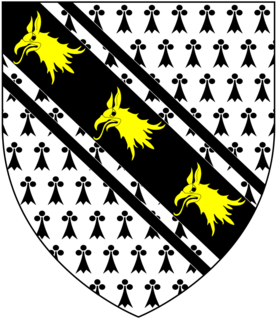
Walter Yonge (1579–1649) of Great House in the parish of Colyton in Devon, England, was a lawyer, merchant and diarist.

Sir Walter Yonge, 2nd Baronet of Great House, Colyton, and of Mohuns Ottery, both in Devon, was a Member of Parliament for Honiton (1659), for Lyme Regis (1660) and for Dartmouth (1667–70).

Sir William Peryam of Little Fulford, near Crediton in Devon, was an English judge who rose to the position of Lord Chief Baron of the Exchequer in 1593, and was knighted by Queen Elizabeth I.
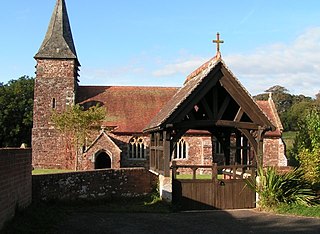
Farringdon is a village, civil parish and former manor in the district of East Devon in the county of Devon, England. The parish is surrounded clockwise from the north by the parishes of Clyst Honiton, Aylesbeare, a small part of Colaton Raleigh, Woodbury, Clyst St Mary and a small part of Sowton.

Escot in the parish of Talaton, near Ottery St Mary in Devon, is an historic estate. The present mansion house known as Escot House is a grade II listed building built in 1837 by Sir John Kennaway, 3rd Baronet to the design of Henry Roberts, to replace an earlier house built in about 1680 by Sir Walter Yonge, 3rd Baronet (1653–1731) of Great House in the parish of Colyton, Devon, to the design of Robert Hooke, which burned down in 1808. Today it remains the home of the Kennaway baronets.
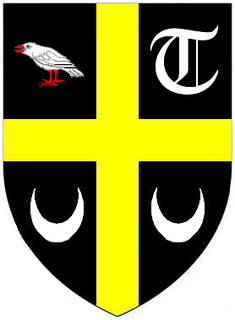
Jonathan I Rashleigh, of Menabilly, near Fowey in Cornwall, was an English shipping-merchant, Member of Parliament for Fowey in 1614, 1621, 1625, April 1640 and November 1640, and 1661 and served as Sheriff of Cornwall in 1627. He supported the Royalist cause during the Civil War.
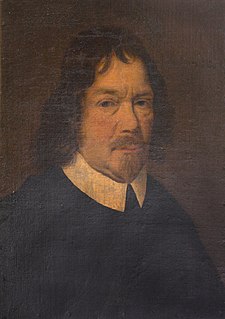
Sir William Pole (1561–1635) of Colcombe House in the parish of Colyton, of Southcote in the parish of Talaton and formerly of Shute House in the parish of Shute, both in Devon, was an English country gentleman and landowner, a colonial investor, Member of Parliament and, most notably, a historian and antiquarian of the County of Devon.

Sir John Davie, 1st Baronet (1588–1654) of Creedy in the parish of Sandford, near Crediton, Devon, was a member of the Devonshire gentry and served as Member of Parliament for Tiverton in 1621-2 and as Sheriff of Devon (1629–1630). He was created a baronet in 1641.

Cofton is a small village, parish and former historic estate, near Dawlish in South Devon, of which parish it formed a part until 1839.
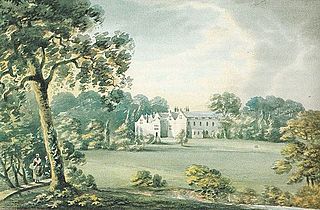
Little Fulford was an historic estate in the parishes of Shobrooke and Crediton, Devon. It briefly share ownership before 1700 with Great Fulford, in Dunsford, about 9 miles (14 km) to the south-west. The Elizabethan mansion house originally called Fulford House was first built by Sir William Peryam (1534-1604), a judge and Lord Chief Baron of the Exchequer. It acquired the diminutive epithet "Little" in about 1700 to distinguish it from Fulford House, Dunsford and was at some time after 1797 renamed Shobrooke House, to remove all remaining confusion between the two places. Peryam's mansion was demolished in 1815 and a new house erected on a different site away from the River Creedy. This new building was subsequently remodelled in 1850 in an Italianate style. It was destroyed by fire in 1945 and demolished, with only the stable block remaining today. The landscaped park survives, open on the south side to the public by permissive access, and crossed in parts by public rights of way, with ancient large trees and two sets of ornate entrance gates with a long decorative stone multiple-arched bridge over a large ornamental lake. The large pleasure garden survives, usually closed to the public, with walled kitchen garden and stone walls and balustrades of terraces. The park and gardens are Grade II listed in the National Register of Historic Parks and Gardens. The estate was the home successively of the families of Peryam, Tuckfield, Hippisley and lastly the Shelley baronets, in whose possession it remains today.
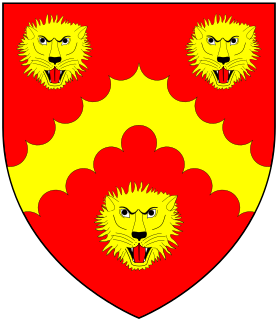
John Peryam, of Exeter, Devon, was elected four times as a Member of Parliament, for Barnstaple 1584, Bossiney 1586, Exeter 1589 and 1593. He served as Mayor of Exeter. He was the younger brother of Sir William Peryam (1534-1604) of Little Fulford, near Crediton in Devon, Lord Chief Baron of the Exchequer.

Creedy is an historic estate in the parish of Sandford, near Crediton in Devon. It is named from its location on the west side of the River Creedy. It was the seat of the Davie family from about 1600 until the late 20th century. The mansion house on the estate has been called at various times New House, Creedy House, and as presently, Creedy Park. It was first built in about 1600, rebuilt in 1846, burnt down in 1915 and rebuilt 1916-21. It is surrounded by a large park, the boundary of which is enclosed by a stone and brick wall several miles long.

Mohuns Ottery or Mohun's Ottery, is a house and historic manor in the parish of Luppitt, 1 mile south-east of the village of Luppitt and 4 miles north-east of Honiton in east Devon, England. From the 14th to the 16th centuries it was a seat of the Carew family. Several manorial court rolls survive at the Somerset Heritage Centre, Taunton, Somerset.

Sir Robert Basset (1573-1641), lord of the manor of Umberleigh and lord of the manor of Heanton Punchardon in Devon, England, was MP for Plymouth in 1593.

Great House on South Street in the town of Colyton, Devon, is the remnant of an historic Elizabethan mansion house built by the Yonge family, originally prominent wool merchants in the town, later Yonge baronets. It is a grade II* listed building.
Thorne in the parish of Ottery St Mary in Devon is an historic estate situated on the west side of the River Otter opposite the town of Ottery St Mary. The site is today occupied by Thorne Farm situated to the immediate north of the town's school and hospital and to the immediate south of the surviving early 17th century grand mansion house of Cadhay.
Collacombe is an historic manor in the parish of Lamerton, Devon, England. The manor house survives as a grade I listed building, known as Collacombe Barton or Collacombe Manor (House).
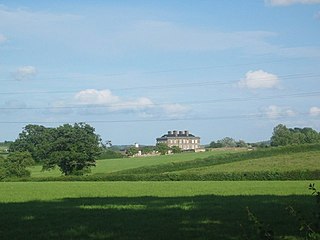
Kingston is an historic estate in the parish of Staverton in Devon, England. The surviving large mansion house, known as Kingston House is a grade II* listed building, rebuilt in 1743 by John Rowe, after a fire had destroyed the previous structure. The Kingston Aisle or Kingston Chapel survives in the parish church of Staverton, built by and for the use of, the successive owners of the Kingston estate.

Indio in the parish of Bovey Tracey in Devon, is an historic estate. The present large mansion house, known as Indio House is a grade II listed building rebuilt in 1850, situated about 1/2 mile south of Bovey Tracey Church, on the opposite side of the River Bovey. According to the Devon historian Pole (d.1635) it was originally a priory, however research from 1840 onwards has suggested it was more likely merely a grange farm, a possession of St John’s Hospital, Bridgwater, Somerset, from 1216.
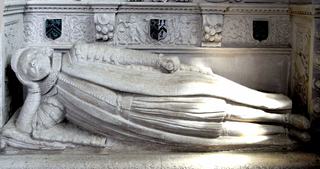
Nicholas Eveleigh (1562–1618) of Parke in the parish of Bovey Tracey in Devon, was an utter barrister, and served as Steward of the Stannary Court of Ashburton, Devon. He died aged 56 when the roof of Chagford Stannary Courthouse collapsed, killing him and nine others. His "sumptuous" monument survives in Bovey Tracey Church.